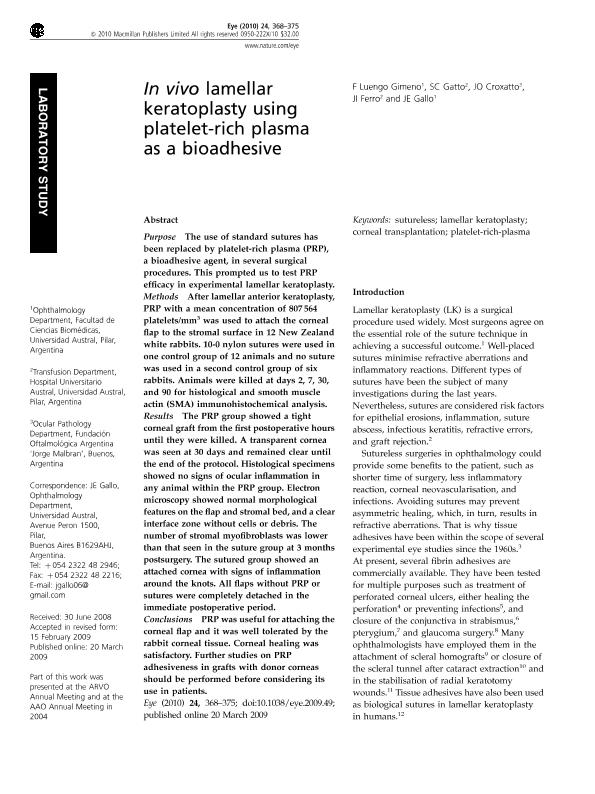Artículo
In vivo lamellar keratoplasty using platelet-rich plasma as a bioadhesive
Fecha de publicación:
02/2010
Editorial:
Nature Publishing Group
Revista:
Eye
ISSN:
0950-222X
Idioma:
Inglés
Tipo de recurso:
Artículo publicado
Clasificación temática:
Resumen
Purpose The use of standard sutures has been replaced by platelet-rich plasma (PRP), a bioadhesive agent, in several surgical procedures. This prompted us to test PRP efficacy in experimental lamellar keratoplasty. Methods After lamellar anterior keratoplasty, PRP with a mean concentration of 807 564 platelets/mm 3 was used to attach the corneal flap to the stromal surface in 12 New Zealand white rabbits. 10-0 nylon sutures were used in one control group of 12 animals and no suture was used in a second control group of six rabbits. Animals were killed at days 2, 7, 30, and 90 for histological and smooth muscle actin (SMA) immunohistochemical analysis. Results The PRP group showed a tight corneal graft from the first postoperative hours until they were killed. A transparent cornea was seen at 30 days and remained clear until the end of the protocol. Histological specimens showed no signs of ocular inflammation in any animal within the PRP group. Electron microscopy showed normal morphological features on the flap and stromal bed, and a clear interface zone without cells or debris. The number of stromal myofibroblasts was lower than that seen in the suture group at 3 months postsurgery. The sutured group showed an attached cornea with signs of inflammation around the knots. All flaps without PRP or sutures were completely detached in the immediate postoperative period. Conclusions PRP was useful for attaching the corneal flap and it was well tolerated by the rabbit corneal tissue. Corneal healing was satisfactory. Further studies on PRP adhesiveness in grafts with donor corneas should be performed before considering its use in patients.
Archivos asociados
Licencia
Identificadores
Colecciones
Articulos(SEDE CENTRAL)
Articulos de SEDE CENTRAL
Articulos de SEDE CENTRAL
Citación
Gimeno, F. Luengo; Gatto, S. C.; Croxatto, Juan Oscar; Ferro, J. I.; Gallo, Juan Eduardo Maria; In vivo lamellar keratoplasty using platelet-rich plasma as a bioadhesive; Nature Publishing Group; Eye; 24; 2; 2-2010; 368-375
Compartir
Altmétricas




